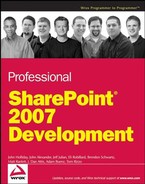Appendix A. Using the Microsoft Visual Studio 2005 Extension for Windows SharePoint Services 3.0
By Adam Buenz
The Microsoft Visual Studio 2005 Extensions for Windows SharePoint Services 3.0 (VSeWSS) enables SharePoint developers to economically and efficiently build the most customary solutions that target and leverage the SharePoint platform. Typical SharePoint development often consists of repetitive, tedious chores when trying to build the foundation for custom solutions such as Web Parts, Site and List Definitions, content types, and deployable packages for distributing customized content across an enterprise environment. SharePoint as a modular development framework implies that several habitual tasks must be performed when constructing new pieces of functionality, in essence, providing the groundwork to integrate and make use of programmatic assets available in the SharePoint environment. VSeWSS seeks to make the life of a SharePoint developer much more painless, truncate development chores, and provide resourceful methods for deployment of robust SharePoint solutions. In essence, VSeWSS is a way to empower a SharePoint developer with enhanced, integrated development tools that offload some of the overhead that is typically required when building against the SharePoint platform.
As an example, consider the groundwork typically required for building the most common solution SharePoint developers tackle, a minimal custom SharePoint Web Part. Under normal circumstances, to build a simple Web Part, a developer has to start off by modifying a Web Control Library Project to include references to the relevant SharePoint assemblies if leveraging the SharePoint object model; build out the appropriate using statements; adjust Web Part class inheritance to target either the Microsoft.SharePoint.WebPartPages.WebPart or System.Web.UI.WebControls.WebParts.WebPart base class; and if doing something small like writing out a small stream of text, build the appropriate writer method by overriding RenderWebPart or RenderContents. Following this, for the Web Part to be installed in the GAC, the binary must be signed with a cryptographic key pair, or a security policy may have to be implemented in order to get the appropriate Code Access Security Rights for deployment in relative bin directories. Once the assembly is built, deployment options have to be considered, since there are various methods to expose and integrate the Web Part into the actual SharePoint environment. Should you auto-create a Web Part description file in the Web Part gallery following the relevant safecontrol entries? Or should you create a deployable .cab solution with the relevant files? Or should you build a SharePoint Feature to reference and deploy the Web Part? Such tasks are targeted and automated by the VSeWSS, and exploiting them appropriately provides an unparalleled platform for building compelling, extendable SharePoint solutions.
